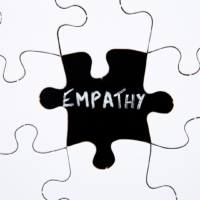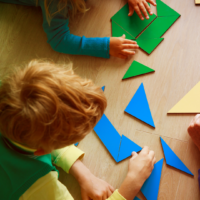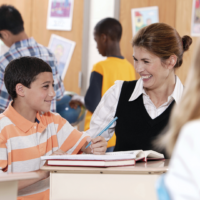How can you use project-based learning in your classroom to build relationships?
By Jennifer Pieratt

“You never really understand a person until you consider things from his point of view… until you climb into his skin and walk around in it.” Atticus Finch’s lessons to his children in To Kill A Mockingbird captures what empathy truly means. According to Happify, empathy lowers stress, improves our relationships, helps us feel connected, and makes us better leaders. However, empathy, according to Bob Sornsen, is also the “heart of a great classroom culture.” When more than 40 percent of children in the U.S. public schools are from culturally diverse backgrounds, empathy has become crucial to build healthy teacher-student and student relationships. Furthermore, school curriculums that purposefully teach empathy often result in better test scores, as demonstrated by Chicago’s One Goal social program. While maintaining healthy relationships with others is obviously a personal affair, teachers have a responsibility to teach students to build empathy for one another and understand the greater world out there. So how can you use project-based learning in your classroom to build relationships? The short answer is to develop 21st-century skills, social and emotional learning, and differentiation.
Imagine a class of students playing outside, absorbed in a giant treasure hunt. This is what elementary school teacher Ellis Reyes thought of when planning a PBL project: GEO-metry caching, a series of engaging mathematical puzzles with hidden geocaches. Through these challenges, the students in his class learn about the area of a square and the hypotenuse of a triangle, as expected, and so much more– they learn 21st-century skills such as agency, critical thinking, flexibility, adaptability, initiative and self-direction, productivity, accountability, and leadership. These are the kind of skills required of audacious, innovative teams in the ‘adult world’, and allow students to slowly develop and model the collaborative dexterity needed for the future workplace. So, how can you use project-based learning in your classroom to build relationships? Take a key 21st-century skill like critical thinking, for instance. By asking students to take a step back in a PBL project and assess whether they have every element of the story at hand, they can navigate between assumptions, facts, and perspectives with an open mind. That comes in handy, whether it be to create an online guided tour of their hometown as their PBL product or to dissolve tensions between friend groups in the class. Project-based learning naturally challenges students to create better relationships in the classroom.
When it comes to academic (and lifelong) success, “cognitive achievement is 50 percent of the equation, and social and emotional skills are the other 50 percent”, says Vicki Zakrzewski, Education Director of The Greater Good Science Centre. The conditions for successful PBL align with Social and Emotional Learning (SEL), which Casel defines as “the process through which children and adults understand and manage emotions, set and achieve positive goals, and feel and show empathy for others,” amongst other things. An excellent example of how SEL can be taught is the “Empathy for Other” project by Teaching4Tomorrow author James Morrissey. After exploring the concept of “otherness” with his students and asking them to share situations where they’ve been the “other”, he created PBL teams and scaffolded projects with this driving question: “How can we help our community build empathy for ‘other’?” These PBL initiatives ranged from building a tremor simulating glove to provoke empathy for those suffering from Parkinson’s disease to coding a game about synesthesia. PBL can be demanding and even frustrating but learning to overcome challenges together, in this case, made students empathize with each other as they learned to identify and effectively communicate their emotions. How can you use project-based learning in your classroom to build relationships? With the right scaffolding, project-based learning can most definitely deepen relationships within the classroom and make students bond in new ways.
The teachers we remember best from our time in the schooling system tend to be those who personally connected with us and adapted their teaching to our interests. Whether they realized it or not, these pioneers were engaging in differentiation, which entails changes to what content teachers deliver to students, how they do so, and how they group and assess their class. These differences are established based on each individual’s personal attributes as well as their interests, their learning style, and what they previously know. Differentiated instruction goes hand in hand with project-based learning to give students a choice and a voice in deciding how they learn. For instance, when teacher Richard Parker challenged his students in Trillium Demonstration School to build or improve a structure that can be used in everyday life, he gave his students carte blanche for what they’d choose to build and how they’d present their reflections, which some did through plays and podcasts and others through Google Slides or an essay. Ultimately, as explained by professor of educational leadership Carol Ann Tomlinson, PBL facilitators, by adapting to each student, can teach learners to compete against themselves rather than against one another, which leads them to work together to increase each other’s success. Yet another example of how PBL can improve relationships in the classroom!
How can you use project-based learning in your classroom to build relationships? We’ve seen that classroom relationships can be strengthened through project-based learning through teaching 21st-century skills, focusing on social and emotional learning, and diving into differentiated learning. Yet the overarching lesson for the students here is empathy, a key part of professional, personal, and stranger-to-stranger relationships. Through the famous 75-year long Harvard Study of Adult Development, psychiatrist Robert Waldinger discovered that “good relationships keep us happier and healthier” to a stunning degree, leading him to state that “tending to your relationships is a form of self-care.” That’s why teaching relationship building is part of what makes project-based learning incredibly relevant to students today – whether it be so that they can solve critical international issues, later on, help the ‘other’ across the street, or just connect with others in a way that gives them happiness and fulfillment.


